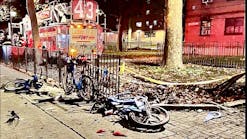RF Siren Systems Introduces Emergency Vehicle Crash Reduction Technology
SALT LAKE CITY, Utah -- Emergency vehicle crashes, injuries and fatalities continue to increase. Aside from thousands of injuries and fatalities, emergency vehicle accidents are costing society an estimated $7 Billion per year.
RF Siren Systems has developed technology and functional prototype devices that enable emergency vehicles to deliver visual and audible siren warnings to the interior of vehicles they encounter.
With most modern cars, outside noises no longer penetrate into closed vehicle interiors. One of the major objectives of the NHTSA, the NTSB and I.I.H.S. is Crash Avoidance.
RF Siren technology can meet that objective today in cost effective fashion and without tax payers funding research of technology RF Siren Systems has developed and has available for implementation. T
he magnitude of this rarely discussed issue, emergency vehicle accidents, is enormous. University of Utah research declares approximately 9,000 ambulance and fire apparatus accidents per year with half resulting in fatalities .
A 2010 Northwestern University study of 466 randomly selected ambulance accidents indicated 962 injuries and 99 fatalities, or a 21 percent probability an ambulance accident will results in a fatality.
The second leading cause of firefighters fatalities are fire apparatus accidents. It is estimated that there are more than 60,000 emergency vehicle accidents in the U.S. each year.
The Los Angeles Police Department paid $24 million in settlements and judgments in 2011 for squad cars accidents (LA Times). Chicago paid $7 million in 2007 (Chicago Tribune). These expenditures are the tip of the iceberg in respect to the cost of emergency vehicle accidents since numerous other such accidents that do not end in a court decision.
"RF Siren's technology is the first significant automotive safety development for the 21st Century and equally important as seat belts and airbags," said Raymond Cannefax, President. "Our fully functional technology will save lives, reduce injuries and save our society billions of dollars each year."
RF Siren Systems is in communication with the U.S. DOT regarding their intent to develop technology to reduce emergency vehicle accidents through "Emergency Vehicle-to-Vehicle" communication.
RF Siren has petitioned Transportation Secretary Ray LaHood to mandate this technology into future cars.
To aid the DOT in their crash reduction research, RF Siren Systems has offered them access to their technology and functional devices/products/tools that are ready for production and implementation.
Salt Lake City Law Enforcement has offered its aid in physically demonstrating the benefits of the technology developed by RF Siren.
The decision to develop this life-saving technology was triggered by the 2007 Taylorsville, UT accident where a police car proceeding through a red light t-boned and killed 27 year old John Douglas, father of two and husband, while driving home after work, and by the fatal July 2012 Ogden accident where 88-year-old Arlene Logan, proceeding trough a green-light intersection was stuck and killed by an ambulance carrying a critically injured crash victim to hospital.
Along with the 2012 Ogden accident fatality, six others were injured. Unfortunately, the ambulance driver, Sean Stephens-Applonie, trying to save the life of the critically injured patient, now faces negligent homicide charges.
The need for this technology was originally conceived by the Company's founder while riding in a Sheriff's car in 2001. The emergency vehicle accident story repeats itself.
In 2008, off-duty Police Officer Jason Weiss, riding his motorcycle, was struck by a Police Car with sirens and lights engaged. The off-duty officer did not hear the siren, suffered a broken leg, and filed a lawsuit against Midvale, UT.
On July 21, 2013, the passenger in a Honda Civic struck by a fire truck in San Diego died at the scene. The driver of the Honda was hospitalized. Quieter automobile interiors, distracted drivers, cell phones, audio systems, conversations and numerous other reasons cause driver distraction and prevent them from hearing sirens until an emergency vehicle is directly upon them.
iPod users hear nothing other than the sounds from their device ear buds. For the thirty million deaf and hearing impaired, unable to hear most sounds, this technology provides a previously unavailable warning alert of an approaching emergency vehicle siren.
A personal-use warning device for deaf and hearing impaired pedestrians ahs been developed, is being tested. Americans with Disabilities Act recognition and benefits are anticipated for this multi-use device (car and pedestrian use).
RF Siren Systems offers cost effective and easy to install technology that consists of emergency vehicle transmitters and RF receivers for new cars and existing vehicles. The radio frequency siren alert signal is activated simultaneously when an emergency vehicle's audible siren and warning lights are activated and instantly delivers visual and audible stimuli to a vehicle's interior.
The stimuli can be displayed on dashboard lights, a specialized rear-view mirror, a stand-alone, aftermarket unit and through audio speakers. Though presently focused on the automotive industry, the Company's technology has numerous other applications covered by RF Siren's pending patent.
Http://rfsiren.com has a page dedicated to its products. Over the years, the U.S. DOT has mandated turn signals, seat belts, head rests, air bags, safety bumpers, side-door reinforcing bars, ABS, and numerous other safety technologies designed to save lives and reduce accident related injuries.
Due to RF Siren's persuasion, the DOT and NHTSA are beginning to address options to improve emergency vehicle signaling capabilities.
Following are two recent quotes from 2013 KSL news reports, Salt Lake City: "For patients who have suffered injuries, severe injuries, quite honestly every second counts,“ Dr. Troy Madsen, University of Utah Hospital "If we can eliminate any cross traffic or any type of a high-risk situation, that's what we want to have done," Chris DeLaMare, Gold Cross Ambulance.





